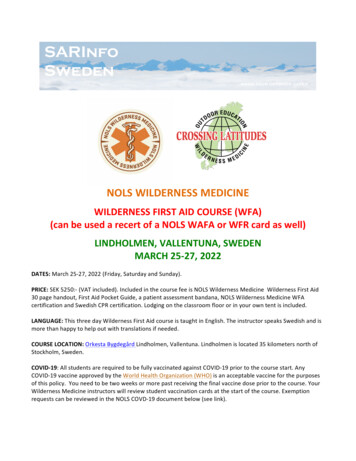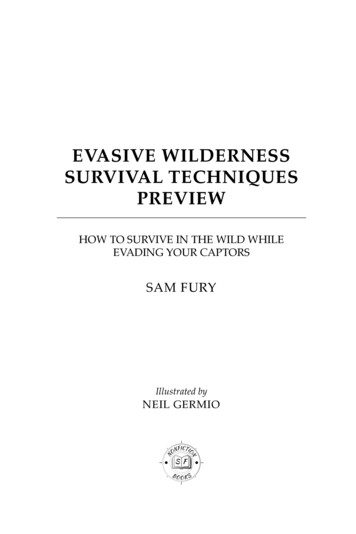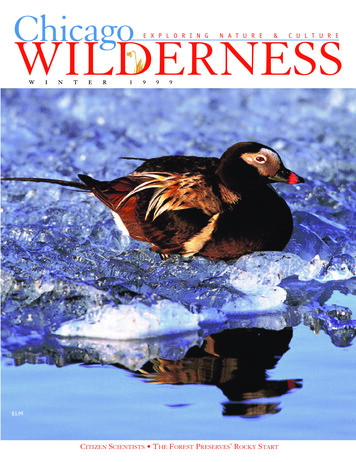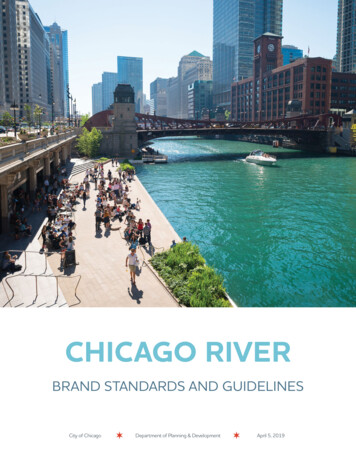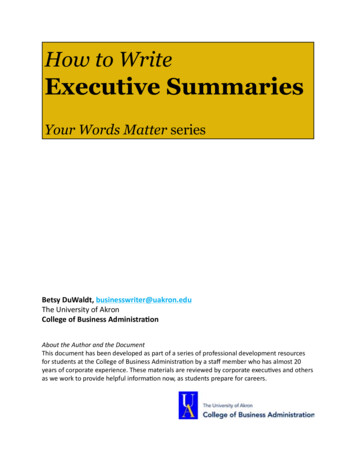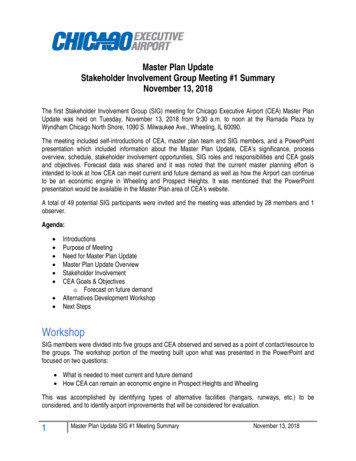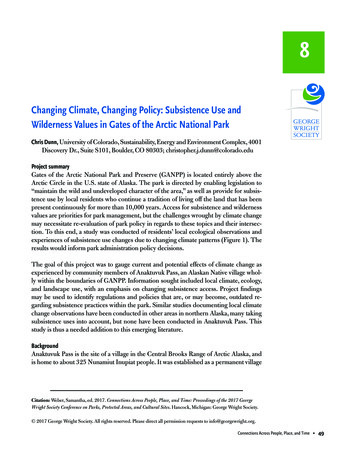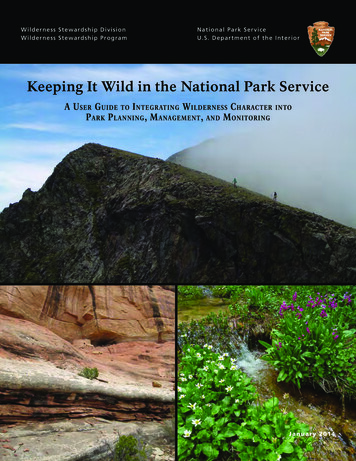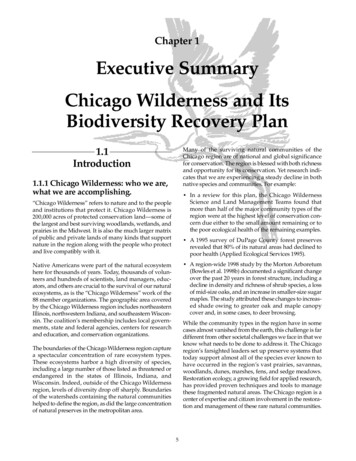
Transcription
Chapter 1Executive SummaryChicago Wilderness and ItsBiodiversity Recovery PlanMany of the surviving natural communities of theChicago region are of national and global significancefor conservation. The region is blessed with both richnessand opportunity for its conservation. Yet research indicates that we are experiencing a steady decline in bothnative species and communities. For example:1.1Introduction1.1.1 Chicago Wilderness: who we are,what we are accomplishing. In a review for this plan, the Chicago WildernessScience and Land Management Teams found thatmore than half of the major community types of theregion were at the highest level of conservation concern due either to the small amount remaining or tothe poor ecological health of the remaining examples.“Chicago Wilderness” refers to nature and to the peopleand institutions that protect it. Chicago Wilderness is200,000 acres of protected conservation land—some ofthe largest and best surviving woodlands, wetlands, andprairies in the Midwest. It is also the much larger matrixof public and private lands of many kinds that supportnature in the region along with the people who protectand live compatibly with it. A 1995 survey of DuPage County forest preservesrevealed that 80% of its natural areas had declined topoor health (Applied Ecological Services 1995). A region-wide 1998 study by the Morton Arboretum(Bowles et al. 1998b) documented a significant changeover the past 20 years in forest structure, including adecline in density and richness of shrub species, a lossof mid-size oaks, and an increase in smaller-size sugarmaples. The study attributed these changes to increased shade owing to greater oak and maple canopycover and, in some cases, to deer browsing.Native Americans were part of the natural ecosystemhere for thousands of years. Today, thousands of volunteers and hundreds of scientists, land managers, educators, and others are crucial to the survival of our naturalecosystems, as is the “Chicago Wilderness” work of the88 member organizations. The geographic area coveredby the Chicago Wilderness region includes northeasternIllinois, northwestern Indiana, and southeastern Wisconsin. The coalition’s membership includes local governments, state and federal agencies, centers for researchand education, and conservation organizations.While the community types in the region have in somecases almost vanished from the earth, this challenge is fardifferent from other societal challenges we face in that weknow what needs to be done to address it. The Chicagoregion’s farsighted leaders set up preserve systems thattoday support almost all of the species ever known tohave occurred in the region’s vast prairies, savannas,woodlands, dunes, marshes, fens, and sedge meadows.Restoration ecology, a growing field for applied research,has provided proven techniques and tools to managethese fragmented natural areas. The Chicago region is acenter of expertise and citizen involvement in the restoration and management of these rare natural communities.The boundaries of the Chicago Wilderness region capturea spectacular concentration of rare ecosystem types.These ecosystems harbor a high diversity of species,including a large number of those listed as threatened orendangered in the states of Illinois, Indiana, andWisconsin. Indeed, outside of the Chicago Wildernessregion, levels of diversity drop off sharply. Boundariesof the watersheds containing the natural communitieshelped to define the region, as did the large concentrationof natural preserves in the metropolitan area.5
Biodiversity Recovery PlanThe purpose of the Chicago Wilderness collaboration isto sustain, restore, and expand our remnant natural communities. Thanks to a great concentration of professionalexpertise and the contributions of thousands of volunteers, we have the ability to achieve this purpose, and ina cost-effective manner. In doing this, we are also enriching the quality of life for ourselves and our children. Nowin its third year, our collaborative effort is starting to takelarger strides to build something big, something thatcould some day transform this region into the world’sfirst urban bioreserve, a metropolitan area where peoplelive in harmony with rare and valuable nature.ment, and they also embody our feelings of shared culture, history, and community. The nations of the worldhave signed a treaty calling biodiversity the commonheritage of humankind and calling on all people to becustodians of the biodiversity found in their countriesand regions.In Chicago Wilderness, the value of biodiversity is notjust at the global level, but most importantly for our owncitizens. Natural communities and species are the basis ofthe region’s environmental health. They provide ecological services in maintaining water quality, abating theimpact of floods, supporting pollination of crops, andcontrolling outbreaks of pests. Equally important, biodiversity contributes immeasurably to the quality of life forthe citizens of the region and to the region’s long-termeconomic vitality. Recent polls and election results showthat residents of the region strongly support protectionof natural areas for the future. Only if we continue andexpand upon the far-sighted conservation work of thosewho built the Chicago region, will we be able to pass theseprecious biodiversity values on to future generations.1.1.2 What is meant by biodiversityand why is it important?The terms ecosystems, natural communities, biodiversity, andsustainability are used throughout this plan. An ecosystem is the combination of living things and the physicalsystems (geology, topography, moisture, climate, etc.)within which they must live. A natural community is themix of plants and animals found living together in ahealthy ecosystem. Sustainability refers to our ability toenjoy and make use of natural communities in a mannerthat does not compromise future generations’ ability todo the same.Yet, there is overwhelming evidence that our projecteddevelopment patterns and their unanticipated resultswill lead to diminishing economic benefits and degradation of the other services that we derive from our livingresources. A further discussion of the benefits of preserving biodiversity and the implications of future growth inthe region are contained later in the Recovery Plan.Biodiversity is the totality of genes, species, and ecosystems in a region. For example, a healthy prairie community would normally include dozens of plant species aswell as habitat for various species of birds, mammals,reptiles, amphibians, insects, mites, fungi, and bacteria.Within a region the size of the Chicago area, biodiversitycan also be measured by the number and variety of natural communities that exist side by side in a given area,such as oak savannas, meadows, and wetlands. A highdegree of biodiversity is normally an indication of a healthy, sustainable natural community, ecosystem, or region.1.1.3 What is the recovery plan?The Biodiversity Recovery Plan is both a plan and aprocess guided by its many sponsors. It is intended as aliving document, not a fixed roadmap, that will continueto evolve as new ideas and information arise. For thatreason, it is a snapshot in time, presenting our best evaluation of the current situation and how we can addressissues and capitalize on opportunities. The success of theplan depends on the responses of those who read it andincorporate its findings and suggestions into their ownwork. Likewise, its future usefulness depends on suggestions for improvement and new priorities from its readers.This plan identifies 49 different natural community typesin the region. Of these, 25 are at least rare or uncommonat the global level, and as many as 23 are globally imperiled. Approximately 1,500 native plant species occur inthe region, making the Chicago metropolitan area one ofthe more botanically rich areas, natural or otherwise, inthe United States. This plan also finds that many of theregion’s animals, including grassland birds, woodlandbirds, savanna reptiles and amphibians, marsh reptilesand amphibians, prairie insects, and savanna and woodland insects, are globally important for conservation.The plan is intended to complement the many otherplanning efforts that are guiding the region toward abetter and more productive future. Foremost amongthese are the plans of the three regional planning commissions; the Northeastern Illinois Planning Commission(NIPC), the Southeastern Wisconsin Regional PlanningCommission (SEWRPC), and the Northwestern IndianaRegional Planning Commission (NIRPC). Other effortsare also contributing to the regional discussions, including the Campaign for Sensible Growth and the Metropolis 2020 Plan.Around the world, people depend on biodiversity for thevery sustenance of life. The living things with which weshare the planet provide us with clean water and air,food, clothing, shelter, medicines, and aesthetic enjoy-6
Chapter 1. Executive Summary: Chicago Wilderness and Its Biodiversity Recovery PlanThis recovery plan outlines the steps necessary to achievethe overall goal of the Chicago Wilderness collaboration.That goal, in summary, is to protect the natural communitiesof the Chicago region and to restore them to long-term viability,in order to enrich the quality of life of its citizens and to contribute to the preservation of global biodiversity.c. Maintain existing quality of publicly owned, highquality natural areas.d. Protect high-quality natural areas in private ownership.e. Mitigate factors with negative impacts that occuroutside of natural areas but within their watershedsor buffer zones.To achieve this goal, the recovery plan identifies the following measurable objectives:4. Restore natural communities to ecological health.1. Involve the citizens, organizations, and agenciesof the region in efforts to conserve biodiversity.a. Reestablish the ecological health of deterioratinghigh-quality natural areas.a. Obtain broad-based and active public participationin the long-term protection, restoration, and stewardship of the region’s natural communities.b. Improve all natural areas, concentrating first onthose that contribute most to global and regionalbiodiversity.b. Strengthen local government support by communicating with and involving officials in planningefforts and conservation programs.c. Provide corridors that link areas as needed.d. Restore ecological processes that support sustainable systems.c. Build partnerships among organizations and agencies in support of biodiversity in the region.e. Return natural communities to sufficient size forviable animal populations by restoring or recreating them. Fermilab and Midewin are examples.d. Maintain and strengthen volunteer participationin stewardship and research.e. Stimulate active private-sector involvement.5. Manage natural communities to sustainnative biodiversity.f. Integrate a broader range of stakeholders, including businesses and constituency organizations intobiodiversity conservation efforts.a. Attain greater capability for ecological management within public entities.b. Encourage sharing of experience and resourcesamong natural-area managers in different jurisdictions.2. Improve the scientific basis of ecologicalmanagement.a. Increase knowledge of species, communities, andecological relationships and processes.c. Monitor recovery progress and status of naturalcommunities.b. Specify results to be achieved in biodiversity andincreased sustainability, including reliable indicators, baselines, and targets.d. Demonstrate the feasibility of protection and restoration in fragmented, human-dominated landscapes, making use of such tools as prescribedburning, restoration of hydrology, and removal ofinvasive species.c. Evaluate the results of restoration and managementalternatives based on data in order to address thosealternatives’ effects on target species and communities.6. Develop citizen awareness and understandingof local biodiversity to ensure support andparticipation.d. Clearly identify conservation priorities.e. Develop region-wide performance standards andmonitoring techniques that can be implemented byland managers.a. Form educational partnerships among citizens,organizations, and agencies to promote awareness.b. Build sufficient awareness of natural communitiesof the region and their global significance so thatthey become a recognized part of the culture of theregion.3. Protect globally and regionally importantnatural communities.a. Identify priority areas and elements for protectionbased on an assessment of their contribution to conserving biodiversity at global and regional levels.c. Develop educational programs to promote broadbased understanding of the global significance ofthe region’s natural communities.b. Protect high-quality natural areas in sufficientacreage to permit restoration and management forsustainability.7
Biodiversity Recovery Pland. Design educational strategies to meet the needs ofall audiences at all levels.A third audience includes all concerned and active citizens. Those who vote, speak out publicly and privately,and make choices of many kinds are crucial participantsin the Chicago Wilderness collaboration. This third audience will be reached primarily through the plan’s components of public participation and education, ratherthan through the plan directly.e. Reach those not traditionally involved with education in natural history or conservation.7. Foster a sustainable relationship between societyand nature in the region.a. Integrate conservation of biodiversity into ongoing development and planning for land use, transportation, and infrastructure.1.1.5 How should differentaudiences use the plan?This recovery plan is intentionally broad in scope, outlining the full range of actions needed across the entireregion to conserve biodiversity. As a consequence, theplan is best viewed as a tool that provides general direction and illustrates the types of actions that can be takento conserve biodiversity. The plan is a blueprint for actionand a reference source for ideas. Because each decision oraction that affects biodiversity will be made in a specificlocal context, and at times local priorities or unavoidableconstraints will suggest a different path than might besuggested as a priority for the entire region, the plan isnot intended as a set of mandates.b. Encourage major land users to adopt practices thatpromote biodiversity and its sustainability by integrating the beauty and function of nature into ourneighborhood, corporate, and public lands.c. Encourage inclusion of biodiversity goals in localplanning and implementation.d. Identify and address factors that lead to sustainableuse.e. Regularly monitor indicators of biodiversity andsustainability throughout the region.f. Support and encourage efforts of citizen scientistsworking to conserve biodiversity.Nonetheless, the priorities and actions in the plan represent a regional consensus on the most important items forprogress on biodiversity conservation. To be effective,those making decisions at the local level in the regionshould consider carefully the issues discussed in the planand attempt to address them in their own planningprocesses. One lesson from the plan is that the region asa whole can sustain biodiversity that is not sustainablethrough local action alone. Success in this regard willonly come if all actors in the region incorporate a broaderregional view in their own decision-making, and if wecooperate across local jurisdictions.8. Enrich the quality of the lives of the region’s citizens.a. Enhance human health through improved air andwater quality as well as protection from flooding byrestoring and maintaining the ecological integrityof natural communities.b. Increase opportunities for all citizens to experiencethe beauty and restorative powers of nature.c. Identify strategies that promote economic growthwhile sustaining biodiversity.1.2The vision1.1.4 Who are the plan’sintended audiences?One primary audience for the Recovery Plan includes thethousands of staff members and hundreds of thousandsof members of Chicago Wilderness organizations. Theseorganizations have accepted responsibility for helpingto define and achieve the results contained in the plan.For the past 200 years, the south end of Lake Michiganhas been the setting of a classic drama. While buildingits economic and cultural wealth, Chicago, one of thenation’s largest metropolises, has partially preserved thenatural communities that had developed here since theretreat of the last glacier, approximately 10,000 years ago.As the metropolis continues to expand, its natural richesdecline. Hence the vision:Another primary audience is all persons who are responsible for making or shaping decisions that affect theregion’s land use, water-resource management, and biodiversity. Included here are local, state, and federalelected and appointed officials and private owners oflarge properties. Also included are key opinion shapersand recognized leaders in the region.To establish a broad policy of beneficial coexistence inwhich the region’s natural heritage is preserved,improved, and expanded even as the metropolis grows.8
Chapter 1. Executive Summary: Chicago Wilderness and Its Biodiversity Recovery PlanAt the landscape level, the vision includes a network ofprotected lands and waters that will preserve habitat fora complete spectrum of the region’s natural communities. More natural land—both public and private—willhave been added to the current core areas and their management will be both active and adaptive. A critical massof sites will be large enough to maintain a sustainablecomplex of interdependent species and natural communities. Carefully monitored habitat corridors will connect sites, both small and large, opening paths for ancientpatterns of migration and dispersal. Fire will be used asa management tool in order to promote ecosystemrenewal. Cycles of prescribed burning will continue thework of lightning and Native American cultures.1.3Key findings andrecommendationsThe Biodiversity Recovery Plan contains a number ofrecommended actions at varied levels of detail andimportance. Some of the more important ones are indicated below, either verbatim or in summary form, withchapter references.1.3.1 Manage more land to protectand restore biodiversity.At the ecosystem level, water will regain its rightfulplace as a natural agent of renewal. Rainstorms will drainmore slowly, with less damage to downstream propertiesand to the streams themselves, due to the capacity fortemporary storage and absorption afforded by naturalopen lands. With appropriate management, preservedlands and water bodies will again host healthy communities of native plants and animals for future generationsto study and enjoy.Much of the region’s legally protected land is not yetbeing effectively managed to preserve remnant nativecommunities. Until recently, it was thought that mosttypes of natural areas, if left alone, would preserve themselves. Studies have increasingly shown that the qualityof our natural communities, including those protected bypublic ownership, is steadily degrading because naturalprocesses have been interrupted and/or because of invasive or overly abundant species. (See Chapter 5.) The continuing degradation of existing preserves is a majorthreat to sustaining and enhancing biodiversity.At the species level, regional populations of animals andplants will be assured long-term viability. Size and connectivity of habitat will contribute to their survival; rarespecies will be protected from catastrophe. Whethernative like deer or alien like purple loosestrife, problemspecies will be prevented from destroying the naturalcommunities in which they live.Ecological management practices are available to dealwith these problems. Limited management is underwayin certain forest preserves and parks and on some privately held lands. But current levels of management are,in most instances, far from adequate. Therefore, this planassigns the highest priority to establishing and maintaining theproper management of natural communities.While our busy lives do not always provide enough opportunityto consider our increasingly precarious relationship withnature, we have reached the point where we must fulfill thisvision to benefit one species more than all others—our own.The region’s human communities will reclaim a culturaltradition of restoring, protecting, and managing the globally outstanding natural communities that enrich ourlives. In the spirit of the far-sighted planners who created this region’s earliest forest preserves, we will makeour built environment compatible with the needs of ourwild neighbors. More resources need to be applied to the managementof protected lands in the region. The shortage of dollarsto manage lands and waters for biodiversity representsa major threat to the region’s natural communities. Inaddition to the high-quality sites being managedtoday, medium- and lower-quality sites, particularlythose containing higher-priority community types,need management efforts. (Chapter 5) State-of-the-art management practices should beapplied more broadly to protected lands. This willrequire more qualified personnel, both volunteer andpaid, than are presently available (Chapters 5, 9, 11).Land managers should apply a diversity of management practices in order to sustain natural communities. (Chapter 5)The foundation for this vision already exists in theregion’s extensive parks and forest preserves, in the regulations protecting wetlands, flood plains, and rare andendangered species, in the investments already made toimprove the quality of water in the region’s streams,rivers, and lakes, and in the public and private institutions whose missions include a concern for the region’snatural environment. Even so, the fulfillment of thevision will require a greatly expanded level of publicunderstanding and support. Indeed, this vision can onlybe realized if it becomes broadly shared. The expanded and more effective use of volunteers inland management, monitoring, and stewardship willbe essential for maintaining the health of conservation lands. (Chapter 11)9
Biodiversity Recovery Plan The use of prescribed fire needs to be greatly expanded. A regional training program should be developed for crew members and burn leaders. Outreachprograms should be used to educate local governments in the use of prescribed fire in managing naturalecosystems. State agencies need to craft air-qualityregulations that foster the expanded use of prescribedburns. Finally, a variety of burn strategies is needed.A single management regime, such as burning at thesame intensity and same time each year, is unlikely tosustain biological diversity. (Chapters 5, 9) Federal, state, and local funding for land acquisitionby county forest preserve and conservation districtsand by other preservation agencies should be expanded with the preservation of biodiversity as a priority.Recognizing that public funds are limited, biodiversityconservation efforts should to the greatest extent possible also support the multiple-use missions of publicagencies. (Chapters 8, 11) In Illinois, the state’s imposition of property-tax capsmakes the funding of further acquisition and management more problematic. Local governments shouldseek to pass referenda as necessary to obtain the revenues needed to achieve this plan. (Chapters 8, 11) Planning for the management of natural communities should be carried out on a countywide or regionalscale, allowing a diversity of management strategiesand effects. For example, wetland managementshould be coordinated on a regional basis to assurethat birds have appropriate habitat within the regionregardless of local fluctuations in wetland conditions.(Chapters 5, 9) State governments should increase funding to openspace grants programs, both for their own lands andfor lands to be acquired by county forest preserve andconservation districts, park districts, and other eligiblejurisdictions. (Chapter 11) Increased federal funding for preserving conservation land is a critical need. High priority should begiven to applications by states and local governmentsthat address critical needs for conserving biodiversityas outlined in this plan. (Chapter 11)1.3.2 Preserve more land with existingor potential benefits for biodiversity.The Chicago region currently contains 200,000 acres ofprotected land in national parks, state parks, regional forest preserves, and open spaces owned and maintained bypark districts, private institutions, and corporations. Allof these lands contain important natural communities orelse serve as buffers, protecting and supporting the natural areas. Over the past few years, local preservationagencies have steadily acquired land for a variety of purposes and they expect to acquire more in the years ahead.This plan recommends that a high priority be given to identifying and preserving important but unprotected natural communities, especially those threatened by development, and toprotecting areas that can function as large blocks of naturalhabitat though restoration and management. The plan recommends that these areas be preserved where possible by theexpansion of public preserves, by the public acquisition of largenew sites, or by the actions of qualified private owners. Land-acquisition plans of public agencies should giveconsideration to the presence of endangered andthreatened species. (Chapter 7) The granting of protective easements and other protective measures by private landowners for naturalareas and buffer zones is an important tool for biodiversity protection and will increase in significance asacquisition of public lands becomes more difficult.More training and resources for the use of these techniques are needed. (Chapter 8)1.3.3 Protect high-quality streams andlakes through watershed planningand mitigation of harmful activitiesto conserve aquatic biodiversity. Public and private agencies should act immediatelyto preserve those high-quality natural areas in theregion that remain unprotected. High-quality remnants, even if small, are important reservoirs of geneticmaterial for maintaining regional biodiversity. Emphasis should be on those community types of higherpriority as outlined in this plan. (Chapter 4, 5)One of the most significant negative impacts of humansettlement on the Chicago region’s natural environmenthas been on streams, rivers, lakes, and wetlands. Draining and filling of wetlands, channelizing of streams,increases in storm-water runoff due to expanding impervious surfaces and resultant changes in the frequencyand extent of floods, changes in groundwater levels, andthe introduction of wastes, chemical products, and erodedsoils into all of the region’s water bodies have had disastrous consequences for virtually all forms of aquatic life. Chicago Wilderness and the regions’ land-owningagencies should develop a priority list of areas needing protection based on regional priorities for biodiversity conservation. (Chapter 5)10
Chapter 1. Executive Summary: Chicago Wilderness and Its Biodiversity Recovery PlanAs urbanization continues, programs, policies, and regulations to manage water resources should be developedand implemented with an eye to sustaining natural communities. The effectiveness of our efforts to managewater resources should be measured, in part, by the number and variety of native species found in aquatic habitatsthroughout the region.There are distinct differences between research, monitoring, and inventory, yet if these activities are linkedtogether in meaningful ways, the results can immediatelybe put to use by conservation practitioners and thus canimprove biodiversity management. Management withinan experimental framework, making use of resultsin future management decisions, is referred to as adaptive management. Developing and implementing a regionalmonitoring program and pursuing a prioritized researchagenda will provide significant contributions to conservationof biodiversity. The highest priority for biodiversity conservation isto maintain the quality of the remaining high-qualitystreams and lakes, those that support high numbers ofnative and threatened species. (Chapter 6) Compile a prioritized list of research needs. Supportresearch projects that will help Chicago Wildernessscientists and land managers to better understand presettlement landscape conditions and processes, current landscape conditions and processes, the besttechniques to restore communities to improved ecological health, and requirements for sustaining biodiversity over the long-term. Examples of specific areasof research needs are given in Chapter 5. State and local public agencies should protect highquality streams and lakes through proper watershedplanning and management, including plans for stormwater management. (Chapters 6, 8) Local agencies should promote natural drainage, create buffer strips and greenways along streams, andcreate or restore streamside wetlands. Attention shouldbe given to changes in groundwater levels for terrestrial communities and wetlands. (Chapters 5, 6, 8) Compile a thorough literature review of previousstudies regarding management of natural communities and conservation of biodiversity relevant to effortsin Chicago Wilderness. (Chapter 9) Local agencies and private landowners should consider restoring streams to their natural meanderingcourses, restoring riffles and other elements of streamhabitat, and using bioengineering solutions to controlstreambank erosion. (Chapter 6, 8) Develop better links with academia and promotemore research projects within the Chicago Wildernessregion. This could be achieved through a number ofapproaches, including setting up a central location ofpriority research needs as a resource for graduate students. Another suggestion is to promote the ChicagoWilderness reg
Chicago Wilderness and Its Biodiversity Recovery Plan 1 . 1 I n t r o d u c t i o n 1.1.1 Chicago Wilderness: who we are, what we are accomplishing. "Chicago Wilderness" refers to nature and to the people and institutions that protect it. Chicago Wilderness is 200,000 acres of protected conservation land—some of



